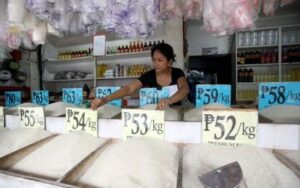The Philippine inflation rate cooled to its lowest level in over five years in April, driven by a steep decline in rice prices that helped offset rising costs in electricity and other essential goods, the Philippine Statistics Authority (PSA) said Tuesday, May 6.
Data from the PSA showed that the consumer price index (CPI) rose 1.4% in April from a year earlier, slowing from March’s 1.8% and marking the slowest pace of inflation since November 2019.
Core inflation, which excludes volatile items such as food and energy, remained at 2.2%, unchanged from March.
National Statistician Dennis Mapa attributed the deceleration largely to rice, the country’s staple food and a heavy-weight item in the inflation basket.
Data from the PSA showed that the price of regular milled rice fell by 13.3% year-on-year to an average of ₱44.45 per kilo in April, from ₱51.25 in the same month last year. Month-on-month, prices also declined 3.6%.
“We continue to see rice prices falling across all tracked varieties,” Mapa said in a briefing. “This substantial drop had a strong downward pull on overall inflation, given rice accounts for 8.9% of the CPI basket and even more for the bottom 30% of households.”
The slowdown may give the Bangko Sentral ng Pilipinas (BSP) more leeway to begin cutting interest rates later this year, aligning with earlier policy guidance. Governor Eli Remolona has said the central bank could start easing in the second half of 2025 if inflation risks remain contained.
However, price pressures persist in other segments. Housing, water, electricity, gas, and other fuels posted a 1.5% annual inflation in April, with electricity inflation alone hitting 5.4%. In Metro Manila, where this group carries more weight than food, electricity inflation surged 18.2%, pushing NCR’s regional inflation higher than the national average.
“The spike in electricity prices is what mainly drove inflation up in the National Capital Region,” Mapa said. “Electricity has a higher weight in the NCR basket compared to areas outside it, where food carries more weight.”
Milk, dairy products, and eggs also saw faster price increases in April, rising 4.0% year-on-year from 3.4% in March, with eggs alone posting an 8.4% increase.
Meanwhile, pork remained among the top contributors to food inflation despite a marginal slowdown. Fresh pork prices rose by up to 9.7% year-on-year in April.
“While the rate of increase slowed slightly, prices are still significantly higher than a year ago,” Mapa said.
Vegetable inflation notably eased, particularly for eggplants, which saw inflation plunge from 23.1% in March to just 1.1% in April, primarily due to improved supply.
Core inflation, which excludes volatile items such as food and fuel, was steady at 2.2% for a second straight month, suggesting underlying price pressures remain manageable.
Asked about the impact of the government’s ambition to sell rice at ₱20 per kilo, Mapa said further price drops would likely push inflation even lower. “Rice has a heavy weight in the basket, so a move to ₱20 would have a significant impact,” he said, while noting the PSA tracks over 700 rice retail outlets nationwide.
Fare hikes, like the April increase in Light Rail Transit rates, had minimal impact due to their small weight in the CPI basket. Inflation in train transport hit 15.5%, but contributed little to the overall figure.
Mapa also downplayed any immediate inflation effects tied to the upcoming election season. “Historically, elections do not cause inflation spikes. Any effect would likely be reflected in household consumption, which we’ll see in Thursday’s GDP report,” he said.
As for the peso’s appreciation in April, the PSA said it has no direct analysis yet, although it acknowledged the exchange rate’s lag effects on inflation could be an area for further research.
From January to April, rice inflation has consistently declined — from -2.3% in January, to -4.9% in February, -7.7% in March, and -10.9% in April — underscoring its central role in the current disinflation trend. (TCSP)




